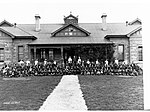Sacred Heart College (Adelaide)
Sacred Heart College is an independent Catholic secondary school, located in the Adelaide beachside suburb of Somerton Park, South Australia and in the suburb of Mitchell Park, in South Australia, Australia. Focused on teaching in the Marist Brothers tradition, the school enrols students from Years 10 to 12.Sacred Heart is known for its Australian rules football teams, cultivating thorough athletes since its establishment. It has an annual Intercollegiate match against its cross-town rival, Rostrevor College, which is a notable event in the South Australian Catholic Schools sports calendar.The school also has an annual exchange with Assumption College in Kilmore, Victoria, which entails music and performing arts performances, debating, social and several sporting competitions.
Excerpt from the Wikipedia article Sacred Heart College (Adelaide) (License: CC BY-SA 3.0, Authors).Sacred Heart College (Adelaide)
Cudmore Street, Adelaide Somerton Park
Geographical coordinates (GPS) Address Nearby Places Show on map
Geographical coordinates (GPS)
| Latitude | Longitude |
|---|---|
| N -34.995555555556 ° | E 138.52 ° |
Address
Sacred Heart College
Cudmore Street
5044 Adelaide, Somerton Park
South Australia, Australia
Open on Google Maps


